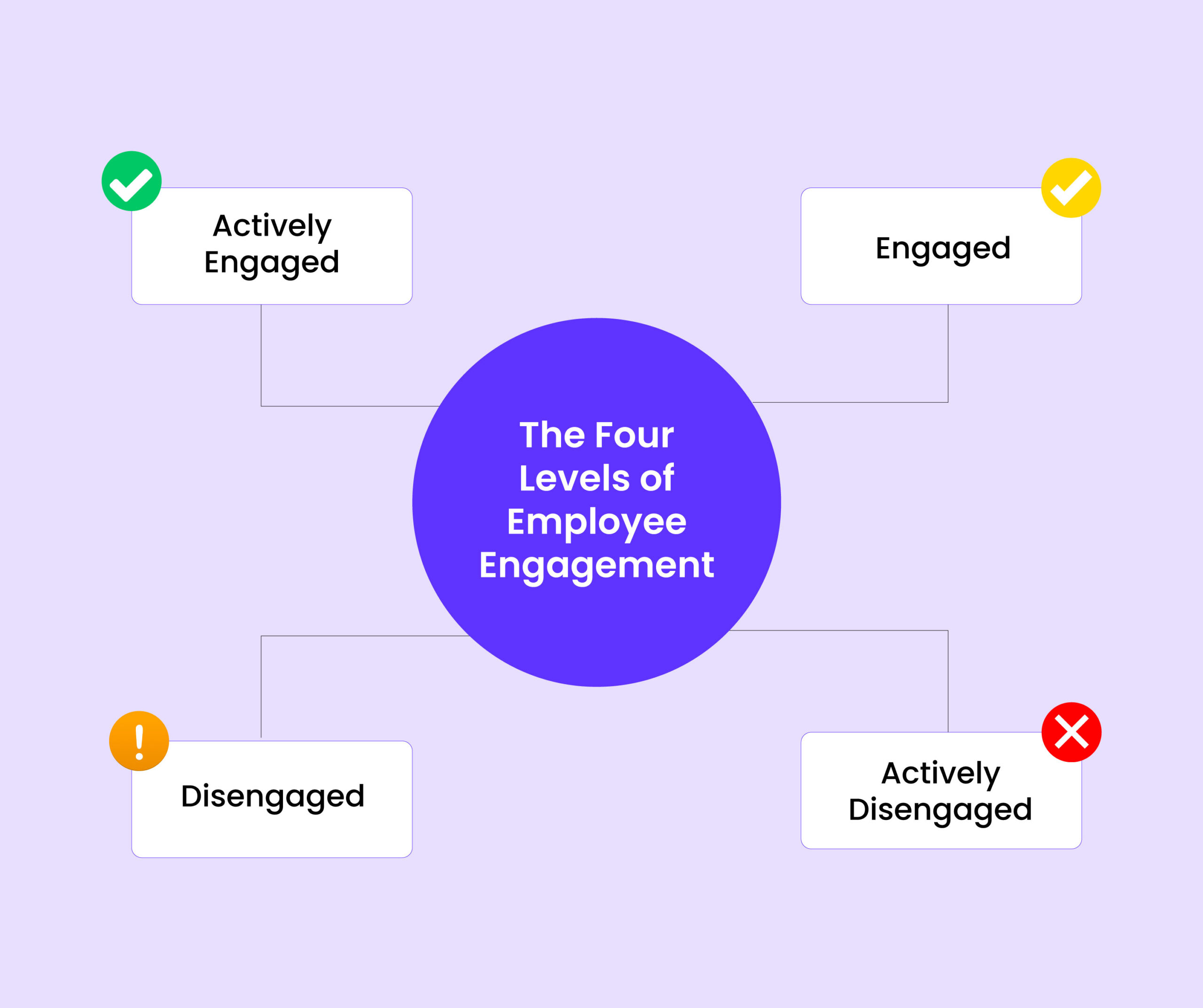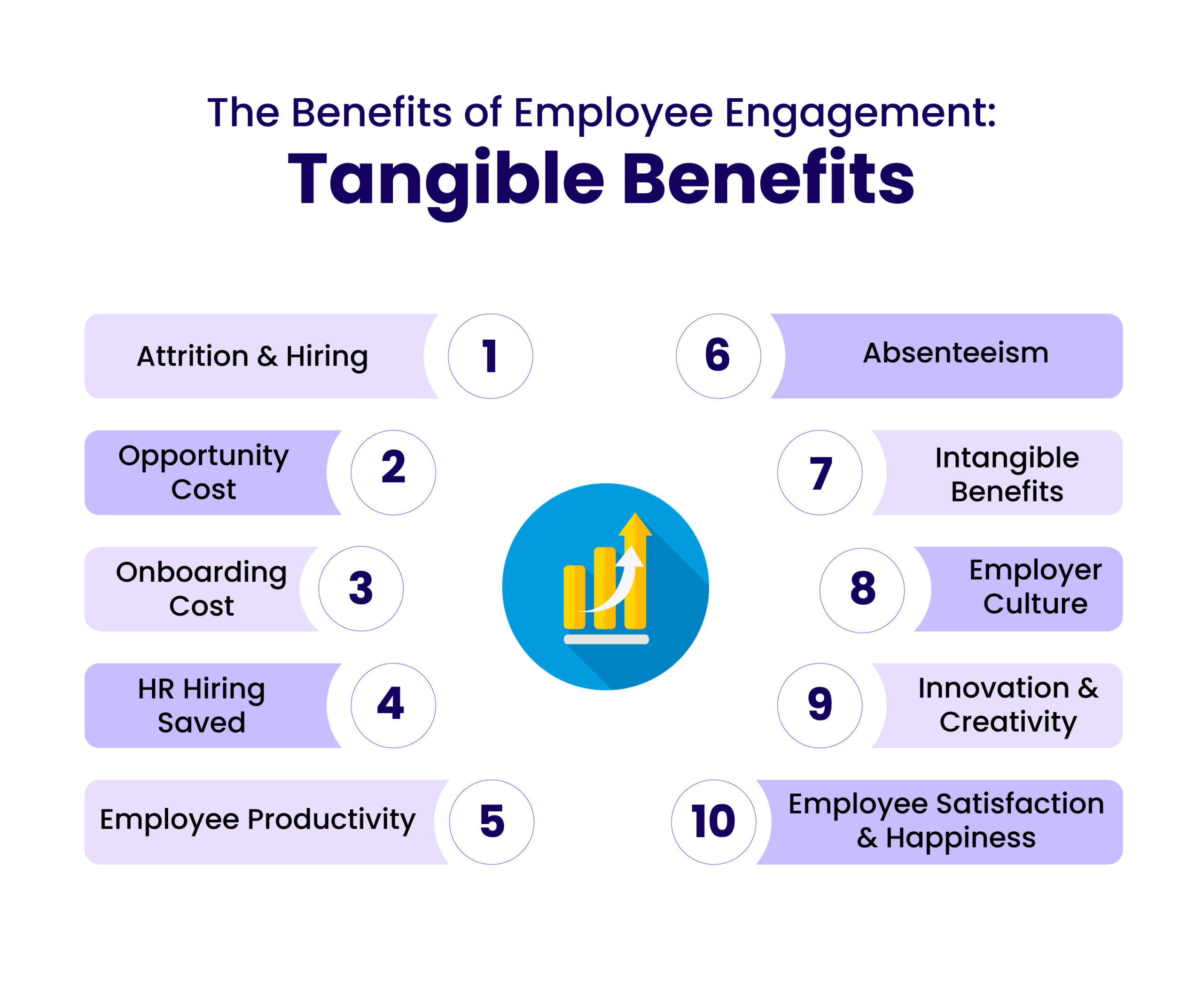There are many factors that contribute to the success of an organization, but the most important one is having a highly engaged workforce. Building a culture in which your employees are loyal and engaged to their work is the key. In this ultimate employee engagement guide, we discover and learn all about the basics of this topic.
What should you expect from this essential guide to employee engagement?
- The What of Employee Engagement: Key drivers of employee engagement
- The Why of Employee Engagement: Benefits of employee engagement
- The How of Employee Engagement: Best employee engagement strategies and tools for measuring employee engagement. How new-age conversational employee engagement platforms play a significant role in elevating employee engagement levels.
What is employee engagement and why is it important?
Employee engagement is the ideal workplace approach that lays the foundation for a loyal workforce and a comprehensively successful organization. It is the fundamental concept that allows HRs to understand and describe the nature of the relationship between organizations and their employees.
Asking why employee engagement is important? is an essential question to consider. Employee engagement is directly linked to the increase in revenue numbers. Everyday employees make decisions related to their job that eventually impact the business outcomes. A highly engaged workforce that is fully engrossed in their work and believes in the organization’s mission can help create a healthy work culture, reduce employee turnover, increase productivity, build better customer relationships, and impact profits.
How does employee engagement embody itself? It is when your employees feel they should emotionally invest in your company’s growth. Employee engagement is also about being included completely as a member of a team, while being focused on your goals, feeling trusted and empowered, being supported in developing new skills, and being rewarded and recognized for your achievements.
The objective behind any employee engagement initiative is to boost the level of employees’ personal investment into their job role. A highly engaged workforce is the manifestation of a holistically successful organization.
With employee engagement being promoted and practiced across the globe, there is a pool of methods that HRs can adopt to boost engagement in their organization. Whether you are new to employee engagement or have been doing it for a while without any guidance, this is your rest stop. In this ultimate employee engagement guide, we deep dive into each aspect of employee engagement.
Let’s begin with understanding some important employee engagement drivers in this essential guide to employee engagement.
What are the key drivers of employee engagement?

People
A major part of employee engagement at the workplace is derived by the people around. A company and its reputation is built by its people. Right from the leadership, managers, colleagues to customers, it is the conduct of people that builds a healthy work culture which further leads to building an engaged workforce. A leadership that inspires its employees, a manager that influences its team, colleagues who always support each other and customers who understand humanity, these factors add remarkably into building an engaged workforce.
Growth
Career growth, learning and development and autonomy are the key factors that increase intrinsic motivation in employees. An organization that invests in the personal and professional development of its employees reap benefits such as motivation, loyalty, productivity, increased engagement, elevated retention levels and much more. Ask your employees what they think is missing, what will help them in employing the best of their potential. Every learning opportunity that you make available to your employees will benefit the business as much as it will benefit them.
Rewards
When employees are recognized, rewarded, appreciated, and enjoy a fair compensation package, sky’s the limit. Everyone wants recognition for a job done well or an achievement, it is one of the most basic of human needs. Employee recognition strengthens individual and team motivation and encourages more of the same behavior.
Communication
Communication and alignment with the vision, mission, road map and direction of the organization is very important. Employees must have a clear sense of what their organization stands for and wants to achieve. They need to be encouraged to speak freely and the leaders must have effective communication channels in place throughout the organization.
Additionally, conscious efforts by the organization to celebrate differences and welcome people of varied backgrounds and life experiences, whether they are employees or clients, can make a significant difference in building inclusion, motivation, and belongingness.
Job
Employees must know their exact roles and responsibilities and the roles of others in the organization. With clarity on each subject, employees will be more willing to put efforts together for a common cause. To execute a job well, your employees need proper tools and resources.
You may not always be aware that they are missing something. The only way to be sure that the proper equipment, materials, tools and potential resources are always available is to create a communication link between staff and management. With everything they need to complete the job at hand, productivity levels go up and so does the revenue.
Work-life
Studies have shown that employee engagement notably increases when an organization demonstrates that it is authentically concerned about the wellness and development of its employees. Every organization must find a balance between operations and the wellness of its workforce, if it wants to keep them fully engaged in their job role. Workplace gathering and activities increase employee morale while also decreasing absenteeism because employees do not wish to miss out on the fun.
Want to learn more about employee engagement benefits? Check out this detailed blog
Read now!What are the four levels of employee engagement?

Actively engaged employees
They are the “A” players who can transform a mundane workplace into a hotbed of innovation, productivity, and fun. When employees work alongside co-workers who are reliable, predictable, and positive, they are capable of accomplishing more than they would if toiling alone. They feel such passion and such a profound connection with what they do and who they do it with, that they have more physiological resources to tackle large, daunting issues, and to innovate in their work.
Engaged employees
Engaged employees are those who work with full passion and are emotionally attached to the organization. They are innovative and provide new ideas and consistent performance to move the organization forward. They internalize the company’s goals and objectives, and always work above and beyond their job requirements for the betterment of the organization.
Disengaged employees
Such employees put in their time, but not passion and energy into their work. These are the ones who do only what is asked of them. They sway between a negative and positive attitude towards the organization. They consider their job as a paycheck, nothing more.
Actively disengaged employees
This set of employees can be easily identified through their absenteeism rate, the quality of the work they deliver, and how much involved they are in the overall culture of the company. Though the causes of employee disengagement may not be always similar, they however, do not associate themselves with the goals and vision of the company and believe in giving only their bare minimum effort to keep the job.
What are the major roadblocks to employee engagement?
While you plan your employee engagement initiatives, there is a high possibility that you will face one or all of the following barriers. Let’s understand what these barriers are and how you can overcome them to make the most of your employee engagement plan:

Goal barrier
One of the most significant challenges is lack of clear vision and definition of engagement. The organization should be very clear about their employee engagement objective, and what employee engagement means to them. An employee engagement initiative without a goal will only result in uncalled expenses, time and resource investment. A goal barrier is often the result of a leadership team that doesn’t understand the benefits of employee engagement and doesn’t prioritize it as a business strategy.
Resource barrier
Another roadblock to employee engagement can be a lack of resources. Imagine a handful of HRs taking care of the needs, documentation, engagement, recruitment and much more, for the entire organization. HRs spend a lot of their time answering repetitive queries about leaves, salaries, and documents, leaving them with little time to focus on more strategic initiatives like employee engagement.
However, with technology making its way into HR tech, there are several tools for measuring employee engagement which require very little human intervention. AI and ML have made it possible to fully automate employee engagement without losing the human-like conversational experience.
Tool barrier
Most organizations are unaware of the advancement in employee engagement. Many HRs are only accustomed to the manual methods or lack the knowledge about the right tools for measuring employee engagement available in the market. Manual or archaic tools make employee engagement seem like a monumental task. But with the right tool, organizations can easily meet their employee engagement objectives.
The right combination of technologies can amplify your employee engagement benefits. People analytics, real-time dashboards, data visualization, NLP, automated processes, AI, action planning, trend, topic, and sentiment analysis are some features of a new-age employee engagement software.
Need some interesting employee engagement ideas? Check out our blog
Read Now!What are the benefits of employee engagement?
Engagement is defined by an employee’s personal investment in their work, organization, and the organization’s goals. This emotional state of engagement encourages employees to build connections that help organizations move forward.
A disengaged workforce brings an organization to a static state where the employees are unhappy with what they have and do not look forward to new challenges or taking-up new initiatives. On the other hand, an engaged workforce allows the organization to move forward by accepting new challenges, bringing innovation, always looking for more to accomplish. Here’s a list of all the benefits of employee engagement, both tangible and intangible, that can move the needle in your organization:
Tangible Benefits

Reduced employee attrition
Engaged employees tend to have long-term associations with the organization, while disengaged employees are always looking for better opportunities. When an engaged employee becomes disengaged, it means a loss of productivity, followed by a loss of skills and knowledge.
The time and money spent on acquiring, interviewing, onboarding, and training a new employee can reflect in an organization’s topline. Therefore, the success of engagement initiatives is as much defined by a boost in the numbers as it is when your employees decide to keep working for your business rather than leave.
Increased employee productivity
Employee engagement is directly linked to employee productivity. When employees are intrinsically motivated, their efficiency and commitment to their work increases automatically. This attitude allows employees to work hard and proactively reach their goals.
According to Leena AI’s Employee Engagement & the Hybrid Workplace Report 2022, close to 20% of organizations saw an improvement in employee productivity as a result of employee engagement initiatives.
Decreased employee absenteeism
Highly engaged employees understand their responsibilities toward their work, and the deadlines assigned to them. As a result, they do not take advantage of certain leave policies or leave work without any consideration.
Opportunity cost
Organizations with high employee engagement levels can notably save the cost of losing valuable employees. A disengaged employee or a quitting employee has an immense impact on the revenue, team, and customers. This can lead to multiple lost opportunities which further increases, retaining costs, onboarding costs, recruitment costs, loss of valuable clients, and more. Continual implementation of employee engagement initiatives can organizations save the cost of such lost opportunities.
Reduced onboarding cost
Onboarding a new employee is a resource, time, and cost-intensive process. It comprises all the equipment and working hours invested in helping a new employee successfully adapt to your organization. However, a highly engaged workforce can lead to a significant decrease in onboarding costs. High employee engagement levels lead to high retention rates which further steers lower employee churn.
Intangible Benefits
Increased innovation
When employees work in a healthy and supportive work environment, they feel open to sharing their ideas and innovative methods. Investing time in innovation gives employees a sense of belonging and accomplishment, which in return drives a much higher added value for the business.
Increased customer satisfaction
When employees are engaged, this reflects in their attitude and how they deal with customers. Creating a positive customer experience, making the customer feel valued, and a smile goes a long way in building a strong customer relationship. This equation also works between the company and its employees.
Improved work-culture
Employees who are fully engaged in their work, carry a completely different attitude. They are the ones responsible for manifesting a culture of loyalty, mutual respect, and accountability. Such a work environment has an influence on employee motivation and employee engagement. This means that good work culture can improve employee engagement significantly.
What are some employee engagement strategies to boost your engagement plan?
To build an effective employee engagement plan, implementation of thoughtful employee engagement strategies becomes inevitable. Your engagement strategies will determine the success or failure of your employee engagement plan. Therefore, selecting the best employee engagement strategies is extremely important. Below, we have listed down 10 employee engagement strategies that promise to yield visible results.
Build trust
Building trust among your employees plays a huge part in allowing them to feel engaged and valued at the workplace. Trust-building activities such as assigning high-priority responsibility, encouraging transparent communication, actively listening to their opinions, and more. A culture of trust in the workplace indicates your employees enjoy honesty, psychological safety, and mutual respect. Without trust, they often feel micromanaged and less important.
Give autonomy
It is important for employees to feel that they have full control of their work. This encourages them to feel responsible for the job at hand and they feel more satisfied with their contributions. When your employees are able to find meaning in their work, engagement builds on its own.
Encourage open communication
Encouraging open communication may sound like a very simple strategy but it brings remarkable changes to the work culture. Employees should have clarity on their org-wide goals, it helps employees gain clarity and must feel they can communicate their ideas and opinions to the management freely.
HR leaders can encourage open communication through the use of intelligent employee engagement survey tools that offer real-time feedback and detailed insights. Unlike traditional survey tools, these new-age survey tools are backed by AI and machine learning. This enables them to find hidden insights from open-ended employee feedback. Such real-time data helps HRs to build future engagement strategies, base employee feedback and track the improvements implemented.
Conduct open feedback sessions
Employees should feel they are an important part of the company and their feedback matters. If your employees do not trust their management with their honest feedback, it is a high possibility they will look for a management that will. Open feedback sessions allow employees to feel valued and heard.
Recognize & reward efforts
Recognizing the efforts and contributions of employees can lead to a major increase in an employee’s motivation to work. Recognition must come from your manager, upper-level management and from your co-workers.
“Publicly recognizing employees not only is great for the individual being recognized but it encourages and gives others something to work towards.” – Sam Caucci, Founder, 1Huddle.
Provide growth & development
Providing quintessential resources to employees for their personal development will strongly impact their capability to get work done. Managers can suggest courses that may help their team to elevate their skillset. Providing such learning opportunities encourages employees to stay with the company.
Set clear goals and expectations
The leadership team must ensure that the goals and expectations for each employee, for every sector, department, and criteria, are set. Not only their personal goals, but also the well-defined objectives of the organization are essential to this exercise. This also indirectly helps the employees find their purpose and understand their role in the organization.
Be flexible
Both formal and occasional use of flexibility are positively associated with employee engagement, and retention. Workplace flexibility is critical to driving employee engagement. Candidates and employees wish to know whether their employer can be flexible or not, as situations change. If they feel stuck in a 9-5 monotonous cycle, they are likely to opt for a company that offers them a flexible working environment.
Encourage diversity, equity & inclusion
Your workforce should not feel any kind of biases or inequality in the company. As a result, diversity, equity, and inclusion are important factors to consider when building a team. Including people of different ages, races, ethnicities, abilities and disabilities, genders, religions, cultures, and sexual orientations. This will help in building a brand name that promotes equality.
Top-down alignment
It is evident that disengaged managers create disengaged employees. Managers have a strong influence on employee engagement. They are the ones responsible for setting job expectations, providing feedback, encouraging individual growth, and building strong teams. Long story short, they are the ones who employees look to for answers. As a result, it is significant to have engaged leaders and managers in the organization.
Prioritize work-life balance
As an employer, one of the key employee engagement objectives must be to ensure the health and mental wellbeing of employees. Both physical and mental health should be prioritized especially if you are working remotely. There are various methods to encourage employee mental health at the workplace. There may be weekly calls (preferably at the end of a week or beginning) just to chat about work and personal life between managers and employees.
Build interactive onboarding process
The employee onboarding process is an extensive way of showing recruits that the organization is much more than what was discussed in the interview rounds. The entire process must be seamless to make new hires believe that they are in the right place and be engaged from day one. Research suggests that “organizations with a strong onboarding process improve new hire retention by 82% and productivity by over 70%”.
What are the best employee engagement tools for your workplace?
To make sure that your employees are engaged by the right methods, you will require certain tools that can help you achieve the set strategies for employee engagement.
Here are some remarkable employee engagement tools that may benefit your organization:

Employee engagement surveys
One of the most efficient tools for measuring employee engagement is surveys. They provide an accurate assessment for most questions regarding employee engagement and, therefore, must be conducted abiding by a specific employee engagement frequency. Apart from answering questions, these surveys also help managers and leaders understand the root causes of all the occurrences so that taking action is much more direct and effective. There are 3 major types of surveys for employee engagement.
Annual surveys
As the name suggests, annual surveys are held once a year. They encourage employees to voice their opinion and share any challenges or setbacks that they are facing under the present leadership. It is the most common type of survey conducted by organizations to bridge the gap between management and employees.
The motive is to get comprehensive insights into an employee’s alignment with organizational goals, motivation to work, mood, and mental health. However, the annual frequency of the surveys provides a lot of insights from a single survey cycle, and at times the data may no longer be relevant.
Employee lifecycle surveys
Employee lifecycle surveys connect the organization with the employee’s milestones and achievements. Each employee achieves certain accolades during their tenure. An employee life-cycle survey helps you leverage their journey and collect feedback about the factors that influence their behavior at each stage.
The most popular lifecycle surveys being used nowadays are onboarding and exit surveys. But, one major challenge with lifecycle surveys is that employees do not trust in the cause of the survey and do not take it as a tool for change. This could be due to the targeted frequency and HRs not taking actions in time.
Pulse surveys
Pulse surveys compared to annual engagement surveys and lifecycle surveys are quick and get speedy responses from employees. These surveys are aimed to get into the pulse of employees and understand any underlying issues that are being overlooked.
Pulse surveys can be easily conducted weekly or bi-monthly asking only 5-10 questions. These surveys are essentially built to address a particular issue or about one essential topic. They help significantly in creating a dynamic, flexible, and trustworthy workplace by keeping a constant tab on the employee mood and expectations.
“The frequency of these surveys varies, but the more frequent the better. Millennials are inherently attracted to feedback and information loops.” – David Farkas, CEO, Upper Ranks.
Voice of the employee tool
Voice of the employee tools can take employee engagement one step further by empowering your organization to listen continuously to your employees’ opinions, suggestions, and complaints. It is the tool that provides organizations with a single touchpoint for employees to voice their concerns to the organization.
The most common VoE tool data sources are survey responses, glassdoor reviews, internal discussion and more. Leveraging these feedback sources, the tool reveals employee pain points, perceptions and preferences.
Backed by intelligent technologies such as people analytics, natural language processing, and machine learning, VoE tool offers real-time insights on employee mood and analyzes employee feedback into actionable insights. But, to hear the true voice of your employee, you need to go beyond quarterly employee surveys and annual engagement surveys. Frequent surveys backed by VoE tool can help in actually manifesting a change in the organization as you will act on data that is relevant.
360 feedback tools
Feedback helps an organization, team, and individual employee develop at a rapid pace. However, channeling the entire feedback system is not easy. The 360 feedback makes things easier, especially for customer-facing and sales-based organizations. For an individual, consolidated feedback is created by managers, peers, and reportees (if any). This process allows performance tracking and may be helpful during the appraisal cycle.
People analytics tool
Two fields that have picked up pace in the HR and future of work domains are people analytics and employee engagement. At the heart of both lies data insights that contribute to making important people’s decisions. The data from each of these fields can be used to strengthen the other, as well as understand and predict employee behaviors.
The fast changing nature of workplaces today require deep insights into employee engagement and people analytics. A tool that combines the two can be powerful in redefining employee experience. Aimed at business growth and employee productivity, people analytics and employee engagement are the route to take to get ahead of the curve.
What should be your employee engagement action plan?

By now, you must have understood that organizational performance and employee engagement share a clear association. Every organization that seeks sustenance and growth quickly responds to the needs of its employees and implements processes to increase employee employee engagement levels.
If you are certain about employee engagement but unsure about the very first step to take, we have it covered. Here are 5 simple steps to building and conducting any employee engagement plan:
Pre-planning
If you don’t know what you are measuring, you will not be able to measure it accurately. The first step in the process is to discover the specific requirements of your organization and decide what matters most. This should be done in consultation with your senior leadership team so that the employee engagement plan is aligned with the company’s goals. Identifying and communicating a focus for your employee engagement plan will set it on the path to success.
Executing
Choose a format that is interesting and interactive for maximum participation. Whether it is an online employee engagement survey or an onsite employee engagement initiative, you must deploy it with the help of appropriate tools and technologies to get the most out of it and have ready data points for analysis.
Result analysis
Your entire employee engagement boils down to this step – how you treat data and what you do with the insights. This step will determine your action items for the next step. Choose a tool that helps with analysis or employ a subject matter expert for this step.
Action planning
To turn the results of the survey into substantial actions is the challenge. Proactively plan actions keeping in mind the results derived from the employee engagement exercise. This will give your employees the confidence to voice their opinions more freely next time and make them feel valued when they see their suggestions being implemented.
Action follow-up & ROI
Action follow-up is necessary in order to find out if the action has been taken in the right direction or not and if it is producing the desired results. Often organizations don’t complete the full cycle and that makes it difficult to calculate the ROI of the employee engagement plan.
Checklist for selecting the right employee engagement software
Employee engagement is critical to the success of an organization, however, executing it correctly is even more critical. That’s why an efficient employee engagement software can be the answer to your employee woes. Let’s take you through a list of features that your software must have.
- An interactive dashboard to offer real-time insights into the key employee engagement metrics and the functionality to automatically analyze employee feedback to deliver immediate results.
- Role-based reporting feature to ensure that managers, leaders, and HR teams have all the required insights to drive success.
- Intelligent and predictive analytics to alert you about employees at higher risk of attrition, have lower job satisfaction, or poor workplace conditions.
- Intuitive data visualization to turn complex data into bite sized information and to highlight areas of improvement.
- Employee-friendly conversational interactive surveys to offer an elegant user experience and meaningful interactions.
- Action-taking tools to provide managers with targeted resources and guidance to take collaborative action with the support of their teams.
- Impeccable data privacy, security, and global compliance to protect the trust of the user and the stakeholder.
- Natural language processing (NLP) technology to automatically identify employee sentiments and key engagement themes.
- Accurate and intelligent algorithms to organize comments into workplace topics.
- Extremely user-friendly and super simple to use software so that employees will not feel intimidated by a platform that is too complex.
- Easy integration with communication channels, HRIS/HRMS, performance management tools/recognition tools team collaboration app.
- A mobile-first platform that employees can easily access right from their personal devices.
- Scalability to ensure that the platform is flexible enough to adapt to your organization’s future needs.
Leena AI: Your partner in building effective and interactive employee engagement

Leena Engage is an employee engagement platform that allows HR leaders to listen to their employees in a streamlined and intelligent manner. It helps organizations achieve the new reality of work where employees expect to be heard, and participate in important business decisions, while enjoying an overall delightful employee experience.
Leena Engage is a one-of-a-kind employee engagement software that guarantees one of the highest participation rates in the market – as high as 90% – through a conversational AI and human-like experience. The platform empowers HRs to listen to their employees, have efficient data points at fingertips, draw insights from a simple and streamlined dashboard, and put those insights to work.
How are Leena AI’s employee engagement surveys different from regular employee engagement surveys? Let’s understand in detail.
The Methodology of Leena AI’s Employee Engagement Solutions
Leena AI‘s engagement surveys implement intelligent analytics after conducting each survey. These analytics help in pointing out the problem areas, unhappy employees, and engagement trends that further help HRs to build data-backed employee engagement development strategies.
Our platform is equipped to identify the key themes and sub-themes for your organization and how they impact your employee engagement levels. Our intelligent employee engagement software assigns different weightage to each theme and tells you which themes to focus on more. The software automatically creates actions on insights that promise the highest impact.
Mood analysis
The platform assigns sentiment scores to 7 primary themes and 48 sub-themes that primarily drive employee engagement. It gives you sentiment scores for each segment of your employees and helps you feel the pulse of your organization at the moment.
Sentiment analytics
The platform is equipped with natural language processing and machine learning. It analyzes all open-text responses right after your employees take the survey. It, then, assigns sentiment scores to the topics and tells you what matters the most to your employees.
Action planning
The platform immediately identifies comments about critical aspects such as bias, harassment, etc. It flags them out for taking immediate corrective action.
Attrition prediction
The platform uses sentiment analysis and text analytics to identify employees who are unhappy and can leave the organization. It creates automatic action plans to retain those employees and empowers the leaders to minimize attrition.
What makes Leena Engage stand out?
- Leena Engage can be easily integrated with your favorite channels such as Slack, Teams, Whatsapp and many more.
- The platform is already connected to Leena AI’s suite of employee experience solutions. with customer support available globally.
- Leena Engage works seamlessly across all major languages
- The AI-powered solution is perfectly capable for enterprises of all sizes
- The system is easy to use and takes minimal time for the HRs.
- The platform is super-friendly to integrate with all major communication channels, apps & HRMSs
- The solution comes with impeccable security standards as it is GDPR compliant
Have a project ? Call us Now
Get In TouchFrequently Asked Questions
Who is responsible for employee engagement?
The seven key drivers of employee engagement are manager, job role, organization, leadership, growth, culture and team. . The impact of these key drivers of engagement does not happen in isolation; the company’s context and culture will lessen or compound their impact on employee engagement.
What is the role of managers in employee engagement?
A highly engaged manager creates a highly engaged workforce. Managers influence the manifestation of a positive or negative work culture. Therefore, hiring highly engaged managers is important to increasing employee engagement levels.
What is the difference between employee engagement and employee satisfaction?
Employee engagement is defined by an employee’s will to go out of their way to perform an assigned task and keep moving forward. Whereas, employee satisfaction is defined by employees enjoying their job role and are stagnant in terms of their skill growth.
What is the difference between employee engagement and employee experience?
The difference between employee engagement and employee experience is—Employee experience is the journey that an employee takes with your company and employee engagement is the level of personal investment that they do during their journey.
What are some good employee engagement strategies?
Some of the best employee engagement strategies are:
- Seamless Onboarding
- Transparent Communication
- Reward & Recognition
- Work-life Balance
- Growth & Development
- Goals and Expectation Setting
- Open Feedback Sessions
- Top-down Engagement
- Diversity, Equity & Inclusion
- Work Flexibility
How to engage employees working from home?
You can build engagement among your remote workforce with employee engagement surveys, 360 degree feedback surveys, conversational AI chatbots, competitive online events, virtual catch-ups and rewards and recognition initiatives.
What is employee engagement?
Employee engagement is an HR approach that is visible through the emotional commitment an employee shares with the organization and its goals.
Why is employee engagement important?
The impact of effective employee engagement can be seen through retention of your best talent, increased employee loyalty, improved organizational performance, and stakeholder value.
How is employee engagement measured?
Employee engagement can be easily measured by conducting frequent surveys and using that data to identify attrition patterns and predicting problems as well as development areas.
How to improve employee engagement?
Here are a few employee engagement best practices that you must adopt to improve your engagement levels:

- Prioritize Communication
- Promote Survey Culture
- Combine Exit Interviews with Exit Surveys
- Announce the Results
- Use Data to Build Your Development Plan
- Measure the Effectiveness






